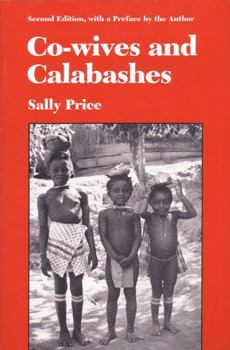Co-Wives and Calabashes
Select Format
Select Condition 
Book Overview
Explores the world of the Saramaka Maroons of Suriname and the status of women as reflected in social structure and art
Format:Paperback
Language:English
ISBN:0472082183
ISBN13:9780472082186
Release Date:April 1993
Publisher:University of Michigan Press
Length:264 Pages
Weight:0.95 lbs.
Dimensions:0.6" x 6.0" x 8.9"
Customer Reviews
1 rating
Art and anthropology
Published by Thriftbooks.com User , 20 years ago
This book is an anthropological investigation of art forms of the Saramakas of Suriname. The Saramakas are a particularly interesting group to study. They are a tribal people living in the Suriname rainforest with relatively few trappings of modern global culture. Yet, their culture, like that of the United States, Israel, or New Zealand, is a recent creation of immigrants from heterogeneous sources brought together in a new land. The Saramakas call themselves "Bush Negroes" and are descendants of slaves who mutinied and led an independent existence in the mountain region of Suriname for centuries. The original Saramakans came from many tribes across several regions of Africa. As described here, they have developed a culture (and language) that displays strong connections to African traditions, but also includes significant Portuguese, Native American, and Dutch elements. The first part of the book explains the structure of Saramakan society, the family structure, and the roles of women and men. Price turns her attention next to the patterns of exchange in the culture. She describes how the practices of giving and receiving between men and women, while reciprocal, are very unequal because of the structure of society and the unbalanced gender ratio in the Saramakan lands. Men are frequently absent for long periods of time while they work for cash on the coast. As a result, women greatly outnumber the men and as expected, polygamy is practiced. Because of their greater access to resources, men are able to give valuable gifts to their wives which are vital for the wives' sustenance. In contrast, the gifts that women give their husbands in return are appreciated but not at all necessary for the husbands' continued existence. Indeed, many of the gifts from the wives are immediately packed away in trunks and never even used by the men. The last part of the book is a detailed examination of the arts, particularly those practiced by women, in Saramakan culture. The most well-known art of the Saramakans are wood carvings done by men. Here Price describes the art created by women, carved calabash bowls and clothing. She details the materials and patterns used, the methods and terminology, and how these have changed over generations. This section of the book is exceptionally well illustrated with black-and-white photographs and diagrams of examples of the art work. The book concludes with a chapter on songs as an expression of Saramakan culture, and a short exploration into the relationship between the structure of a society and how it is played out in the arts. It is this very last section that is truly the most interesting part of the book. I, myself, don't have an artistic bent, and much of the detailed description of Saramakan textile art went way over my head. But as Price drew the details from the two parts of the book together in her conclusion, I finally began to understand the scope of her work and its implications. It leads






